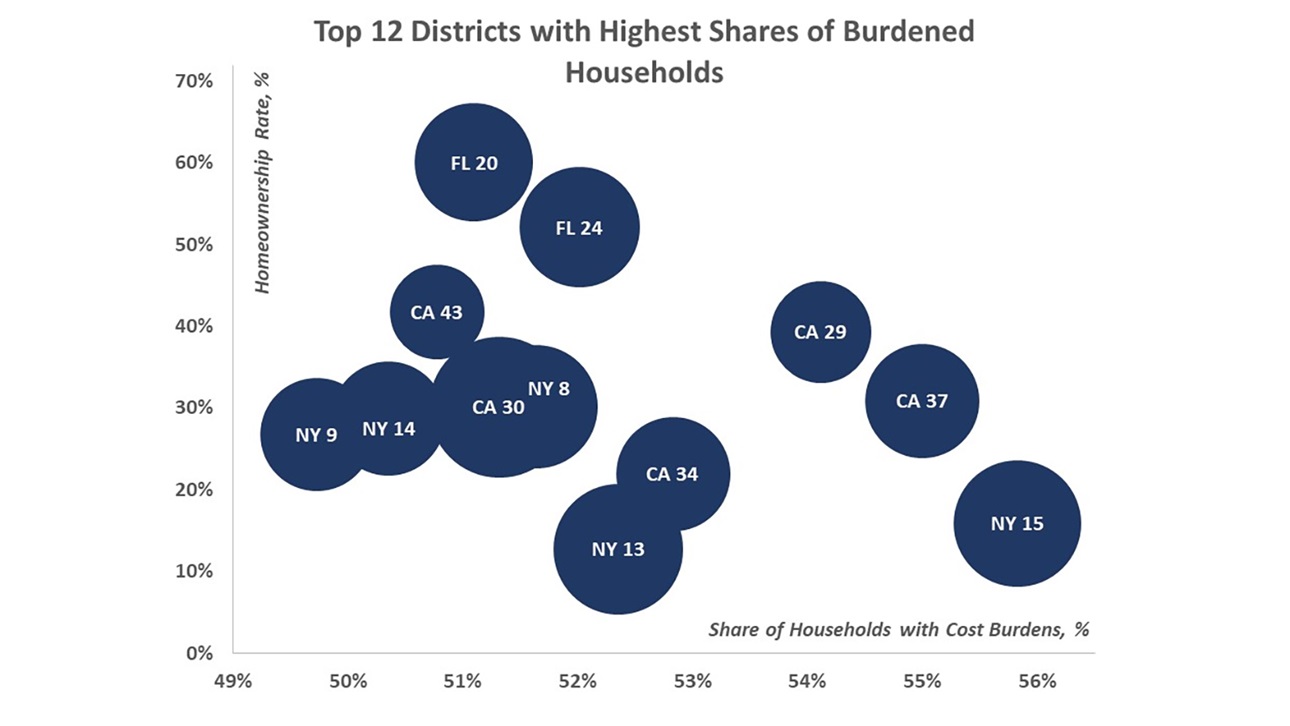Housing Cost Burdens Across Congressional Districts
Buoyed by significant home equity gains and locked in by below-market mortgages rates, current home owners are in a more advantageous financial position to weather the growing affordability crisis. At the same time, renters are facing the worst affordability on record.
According to the latest 2023 American Community Survey (ACS), more than half of all renter households (23 million) spend 30% or more of their income on housing and are therefore considered burdened by housing costs. Among home owners, the share of cost-burdened households is less than a quarter (24%), which amounts to 20.6 million owner households.
As a result, congressional districts where housing markets are dominated by renters are more likely to register higher overall shares of households with cost burdens.
In a typical congressional district, about a third of all households — renters and owners combined — experience housing cost burdens. In contrast, in the 10 congressional districts with the highest burden rates, more than half of all households spend 30% or more of their income on housing.

The highest burden rates are found in California, New York and Florida. In New York’s 15th and 13th, 55% and 52% of households, respectively, are burdened with housing costs. The vast majority of these households are renters, as reflected by the low homeownership rates in these districts (16% and 13%, respectively).
Similarly, the remaining top 10 districts with the highest shares of burdened households have homeownership rates well below the national average of 65%. On that list, only Florida’s 20th and 24th have homeownership rates that exceed 50%.
Because congressional districts are drawn to represent roughly the same number of people, higher shares typically translate into larger counts of cost burdened households. To capture any remaining differences, the size of the bubbles in the chart correlates with the overall number of burdened households.
On the rental side, nine out of 11 worst burdened districts are in Florida. Close to two-thirds of renters in Florida’s 26th, 20th, 25th and 19th districts are burdened with housing costs. The renter burden rates are similarly high in Florida’s 28th, 21st, 24th, 13th and 23rd districts, where the shares of cost-burdened renters are between 63% and 64%. Only California’s 27th and 29th districts register slightly higher burden shares exceeding 64%.
Florida, New York and California stand out for simultaneously having congressional districts with the highest shares of cost-burdened renters and owners. Although high property taxes contribute heavily to owners’ burden in New York and California, increasing insurance premiums strain home owners’ budgets in Florida.
See this Eye on Housing post from NAHB AVP of Housing Research Natalia Siniavskaia for more details, or view more housing data for your congressional district through the U.S. Census Bureau.
Latest from NAHBNow
Dec 23, 2025
The 5 Types of Builders — and the One Built to ProsperMost builders want the same things: predictable profits, less stress, and a business that doesn’t grind them down year after year.
Dec 23, 2025
Lumber Capacity Has Peaked for 2025An annual revision to the Federal Reserve G.17 Industrial Production report shows current sawmill production levels above 2017 by 7.5%, but just 0.3% above 2023 levels.
Latest Economic News
Dec 22, 2025
State-Level Employment Situation: September 2025In September 2025, nonfarm payroll employment was largely unchanged across states on a monthly basis, with a limited number of states seeing statistically significant increases or decreases. This reflects generally stable job counts across states despite broader labor market fluctuations. The data were impacted by collection delays due to the federal government shutdown.
Dec 19, 2025
Existing Home Sales Edge Higher in NovemberExisting home sales rose for the third consecutive month in November as lower mortgage rates continued to boost home sales, according to the National Association of Realtors (NAR). However, the increase remained modest as mortgage rates still stayed above 6% while down from recent highs. The weakening job market also weighed on buyer activity.
Dec 18, 2025
Lumber Capacity Lower Midway Through 2025Sawmill production has remained essentially flat over the past two years, according to the Federal Reserve G.17 Industrial Production report. This most recent data release contained an annual revision, which resulted in higher estimates for both production and capacity in U.S. sawmills.
